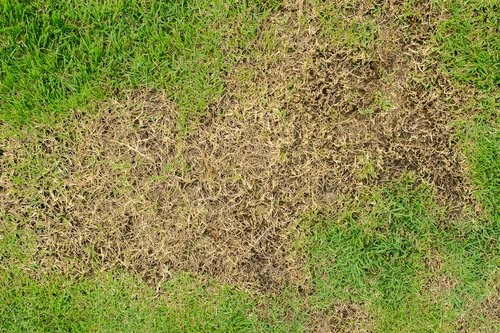- By CycreekPestAdmin
- In General
- Tags General
As a homeowner, dead, brown patches in your lawn is a sight you probably don’t enjoy seeing. If you begin noticing these problems areas in your otherwise green lawn, you may have sod webworms. Sod webworms are the larval stage of a small brown moth, and they are an annual occurrence in the Houston area during spring. Here’s what you need to know to identify if you have a sod webworm problem.
What Do Sod Webworms Look Like?
A sod webworm, as noted, is the larval stage of a group of small, brown moths that target turfs and lawns. They can reach up to one inch in length and vary in color, from brown to green or gray. Their bodies feature dark spots, and their heads are generally a darker shade than the rest of their body. If disturbed, they’ll roll up into a small ball.
What’s Their Lifespan?
Young sod webworms hibernate during fall and winter in silk-lined tunnels near your soil’s surface or the thatch. The thatch is an organic layer in your lawn between your grown grass and dirt that consists of dead, dying, and living roots. When the temperatures warm up, they resume feeding in the thatch, typically in late April or early May.
In June, sod webworms cocoon themselves and emerge as adult moths approximately 10-14 days later. After that, they begin mating almost immediately. Female moths fly just above your lawn’s surface, leaving up to 200 eggs randomly scattered throughout your grass. These eggs hatch and begin feeding until mid-summer until they’re ready to overwinter again. So, at any point, you may have up to two to three generations of sod webworms in your lawn.
What Damage Do They Cause?
Sod webworms are always above ground, feeding on grass blades. When these lawn pests are small, they eat the soft leaf tissue of plants, leaving the veins of the leaf behind. As they get larger, they start eating the entire blade, leaving behind a visible “notched” appearance. Soon, they’ll eat full leaves, cutting the grass off at the crown. This is what causes brown patches. If untreated, they’ll continue these patterns until your small brown spots turn into large, dead sections of lawn. In the worst situations, your entire yard can be destroyed.
Also read: Why Sod Webworms are a Threat to Your Lawn
How Do I Detect Sod Webworms?
You’re most likely to find sod webworms in turfgrass, bluegrass, bentgrass, tall grass, and buffalo grass. To look for them in your grass, begin by examining the thatch layer or top inch soil for signs of silken tubes or webbing. As described, when they’re young, they feed on the soft leaf tissue of plants, which is generally the underside of leaves. Check here for damage that looks that has a chewed, grazed, or scalped appearance.
Another critical thing to note is sod webworms prefer sunny areas. They favor direct sunlight or south-facing slopes. Areas with a lot of shade are rarely attacked, so it’s doubtful to find these insects in those spots.
How Do I Prevent Them?
It can be tough to prevent adult webworm moths from laying eggs in your lawn, especially if there were already sod webworms present in the summer. But, there are a couple of methods you can take to prevent extensive damage to your lawn.
- Properly maintain your lawn. In general, a well-kept lawn is your best bet against sod webworms from ever entering your garden. This means regularly watering your plants – but not overwatering them because overwatered lawns are enticing to adult moths ready to lay eggs – and reducing any stresses on your yard.
- Reducing excess thatch. The thatch of your lawn provides shelter for sod webworms when they’re resting. Proper thatch maintenance will reduce the areas they can hide and feed.
Continue Reading: Spring: The Perfect Time for Preventative Pest Control
How Do I Get Rid of Sod Webworms?
While there are some over-the-counter and at-home methods to rid yourself of sod webworms, your best bet to eliminate the problem before it gets worse is to call in professional help. You may be able to identify one or two in your lawn, but a Houston pest control professional, like Cypress Creek, will be able to determine the correct amount in your garden and provide proper assistance. If you think you have a sod webworm issue, contact us today to take advantage of our one-year warranty on sod webworm treatment.



